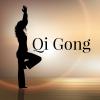CYBERMED LIFE - ORGANIC & NATURAL LIVING
CYBERMED LIFE - ORGANIC & NATURAL LIVING
 Qigong (/ˈtʃiːˈɡɒŋ/), qi gong, chi kung, or chi gung (simplified Chinese: 气功; traditional Chinese: 氣功; pinyin: qìgōng; Wade–Giles: chi gong; literally: "Life Energy Cultivation") is a holistic system of coordinated body posture and movement, breathing, and meditation used in the belief that it promotes health, spirituality, and martial arts training. With roots in Chinese medicine, philosophy, and martial arts, qigong is traditionally viewed as a practice to cultivate and balance qi (chi), translated as "life energy".
Qigong (/ˈtʃiːˈɡɒŋ/), qi gong, chi kung, or chi gung (simplified Chinese: 气功; traditional Chinese: 氣功; pinyin: qìgōng; Wade–Giles: chi gong; literally: "Life Energy Cultivation") is a holistic system of coordinated body posture and movement, breathing, and meditation used in the belief that it promotes health, spirituality, and martial arts training. With roots in Chinese medicine, philosophy, and martial arts, qigong is traditionally viewed as a practice to cultivate and balance qi (chi), translated as "life energy".
According to Taoist, Buddhist, and Confucian philosophy, qigong allows access to higher realms of awareness, awakens one's "true nature", and helps develop human potential.
Qigong practice typically involves moving meditation, coordinating slow flowing movement, deep rhythmic breathing, and calm meditative state of mind. Qigong is now practiced throughout China and worldwide for recreation, exercise and relaxation, preventive medicine and self-healing, alternative medicine, meditation and self-cultivation, and training for martial arts.
Research concerning qigong has been conducted for a wide range of medical conditions, including hypertension, pain, and cancer treatment. Systematic reviews of clinical trials have been low quality and inconclusive, leading to determinations that there is no evidence as of 2018 that qigong provides health benefits.